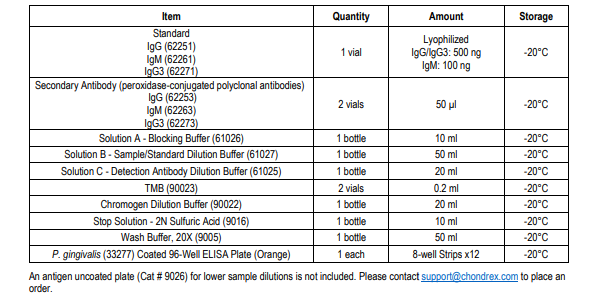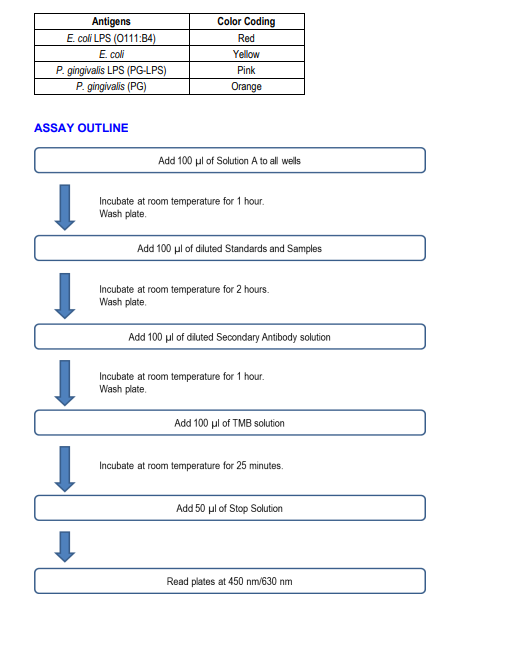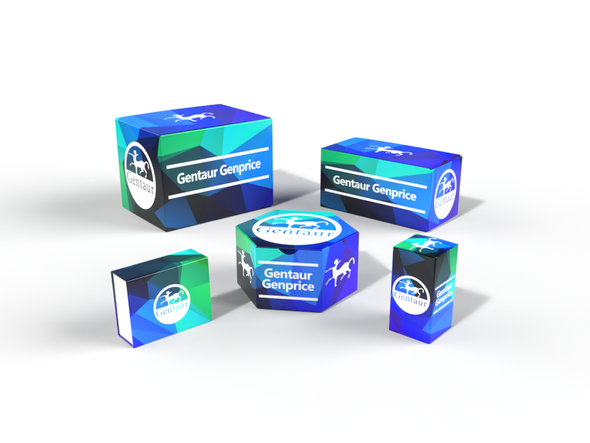Description
Mouse Anti- P. gingivalis IgM Antivody Assay Kit - Cat Number: 6226 From .
Research Field: Bacterial Research, Immunology
Clonality: N/A
Cross-Reactivity:
Host Origin: N/A
Applications: N/A
Isotype: N/A
Detection Range: 100 ng/ml-1.6 ng/ml
Sample Type: Serum, Plasma
Concentration: N/A
Immunogen:
PRODUCT SPECIFICATIONS
DESCRIPTION: ELISA kits to quantify mouse anti-PG IgG/IgM/IgG3 antibodies
6225: Mouse Anti-PG IgG Antibody ELISA Kit
6226: Mouse Anti-PG IgM Antibody ELISA Kit
6227: Mouse Anti-PG IgG3 Antibody ELISA Kit
FORMAT: Pre-coated 96-well ELISA Plate with removeable strips
ASSAY TYPE: Indirect ELISA
TIME: 4.5 hours
STANDARD RANGE: 6225/6227 : 500 ng/ml to 8 ng/ml
6226 : 100 ng/ml to 1.6 ng/ml
NUMBER OF SAMPLES: Up to 40 (duplicate) diluted samples/plate and up to 20 (duplicate) low dilution samples/plate
SAMPLE TYPES: Serum and Plasma
RECOMMENDED SAMPLE DILUTIONS: 1:200 (at least)
CHROMOGEN: TMB (read at 450 nm)
STORAGE: -20°C
VALIDATION DATA: 6225: Intra-Assay (1.2-8.4%)/Inter-Assay (2-7.1%)/Spiking Test (95-103%)
6226: Intra-Assay (0.7-3.2%)/Inter-Assay (1.4-6.9%)/Spiking Test (91-95%)
6227: Intra-Assay (1.5-4.7%)/Inter-Assay (4.8-9.6%)/Spiking Test (91-95%)
NOTES:
INTRODUCTION
Recent studies indicate that environmental factors, especially intestinal microbiota and their toxins, may play roles in the development of autoimmune diseases such as rheumatoid arthritis (RA) (1-7), inflammatory bowel diseases (IBDs) (8, 9), systemic lupus erythematosus (SLE) (10), and other chronic disorders (11-13). In fact, germ-free mice fail to develop ankylosing enthesopathy, a naturally occurring joint disease in mice with many parallels to human ankylosing spondylitis (15). Moreover, several studies indicate that increased intestinal mucosal permeability due to stress, surgery, and minor gastrointestinal disorders such as irregularity, may contribute to excess translocation of gut bacteria and their toxins into the body (16-18). These events suggest the pathological importance of intestinal bacteria with regard to autoimmune disorders.
Among the many environmental factors, gram-negative bacteria and their toxins, such as Porphyromonas gingivalis (P. gingivalis), Escherichia coli (E. coli), and lipopolysaccharide (LPS), induce inflammation by increasing levels of inflammatory cytokines, and may be involved in various types of chronic autoimmune disorders. In fact, chronic P. gingivalis oral infection prior to arthritis induction increases the likelihood of Th17 cell responses, ultimately accelerating collagen-induced arthritis (CIA) development in mice (19). Interestingly, orally administered P. gingivalis also perturbs gut microbiomes in CIA mice, affecting the gut immune system and the gut microbiota composition (20). Beyond autoimmune disorders, P. gingivalis components have also been identified in the brains of Alzheimer’s Disease patients. The chronic P. gingivalis infection may change the permeability of the brain-blood barrier and reduce the efflux of β-amyloids from the central nervous system into systemic circulation (21).
In order to advance these microbiome-related research fields, , Inc. provides mouse anti- P. gingivalis (33277) and P. gingivalis - LPS (33277) antibody ELISA kits to elucidate the host immune response to potential environmental pathogens. For a complete list of available mouse anti-bacteria and bacterial toxins antibody ELISA kits, such as E. coli (O111:B4), E. coli -LPS (O111:B4), and staphylococcal enterotoxins, please visit www..com or contact us at support@.com.

IDENTIFICATION OF ANTIGEN-COATED STRIPS

PLATE MAPPING
Map the plate based on the number of samples and sample dilution. For example, if sample dilution is higher than 1:200, it is not necessary to run antigen un-coated wells, but if sample dilution is less than 1:200, it may be necessary to run antigen uncoated wells to determine the background noise reaction OD values of individual samples. An antigen uncoated plate (Catalog # 9026) for lower sample dilutions is not included. Please contact support@.com to place an order.

NOTES BEFORE USING ASSAY
NOTE 1: It is recommended that the standard and samples be run in duplicate.
NOTE 2: Warm up all buffers to room temperature before use.
NOTE 3: Crystals may form in Wash Buffer, 20X when stored at cold temperatures. If crystals have formed, warm the wash buffer by placing the bottle in warm water until crystals are completely dissolved.
NOTE 4: Measure exact volume of buffers using a serological pipet, as extra buffer is provided.
NOTE 5: Cover the plate with plastic wrap or a plate sealer after each step to prevent evaporation from the outside wells of the plate.
NOTE 6: For partial reagent use, please see the assay protocol’s corresponding step for the appropriate dilution ratio. For example, if the protocol dilutes 50 µl of a stock solution in 10 ml of buffer for 12 strips, then for 6 strips, dilute 25 µl of the stock solution in 5 ml of buffer. Partially used stock reagents may be kept in their original vials and stored at -20⁰C for use in a future assay.
NOTE 7: This kit contains animal components from non-infectious animals and should be treated as potential biohazards in use and for disposal.










